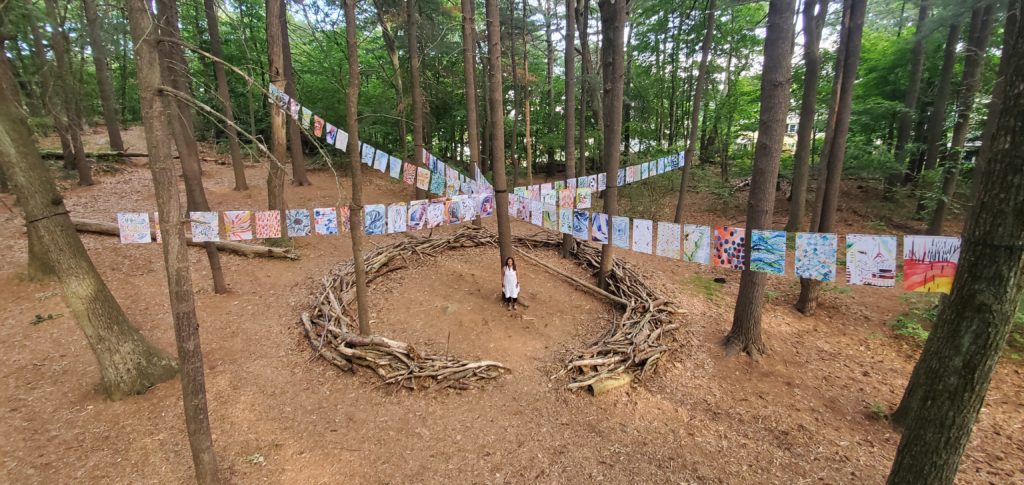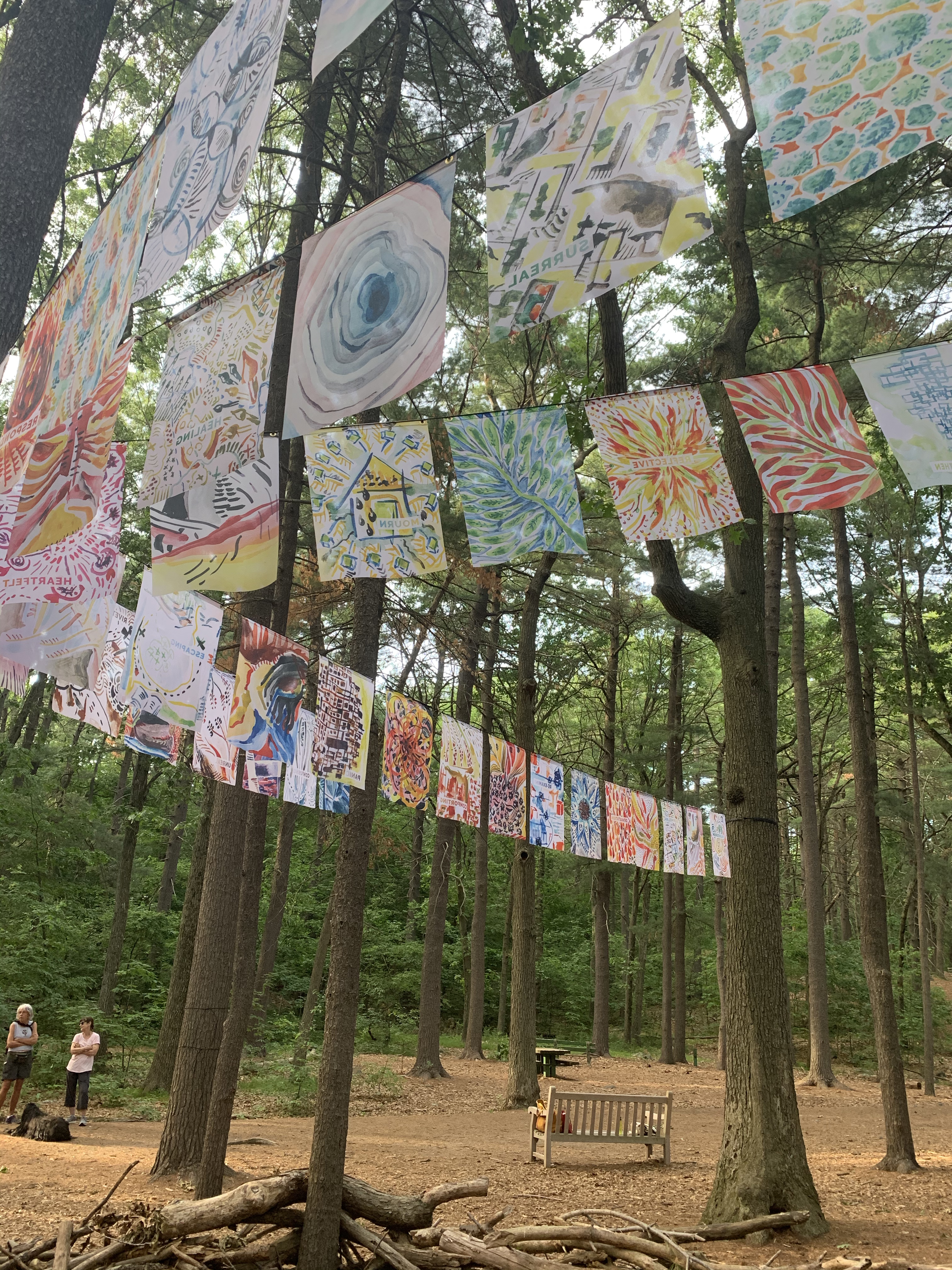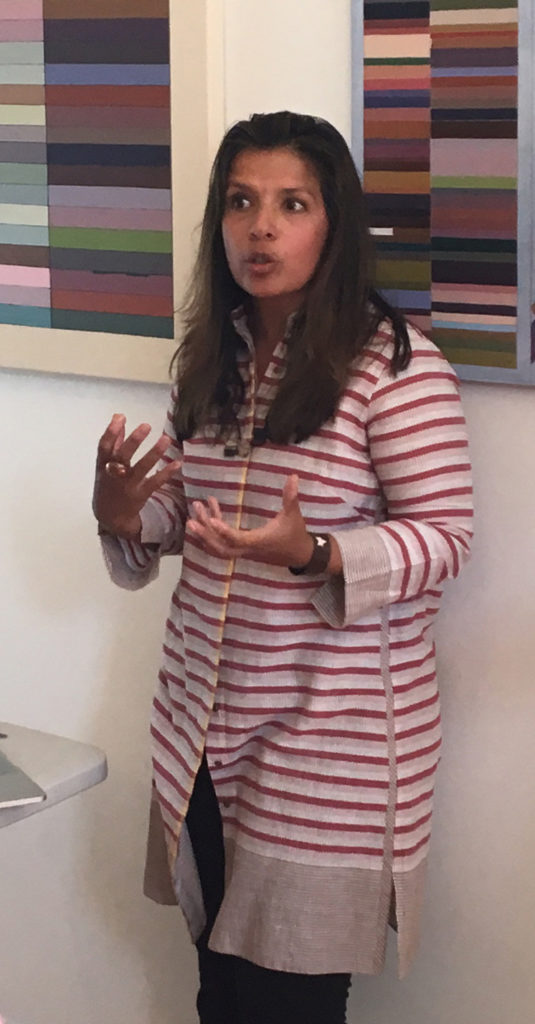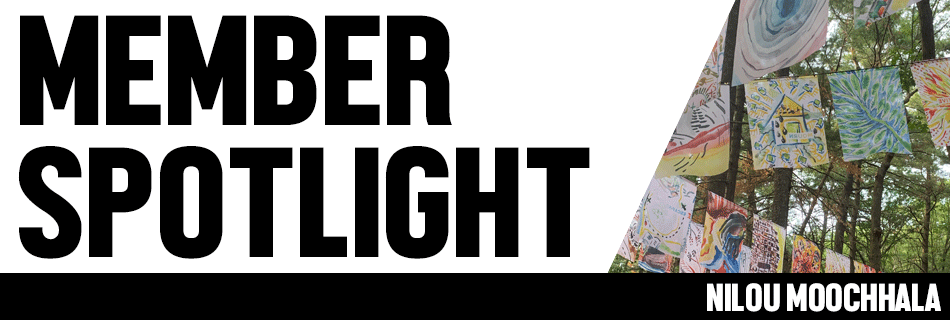
Nilou Moochhala
Nilou Moochhala’s visual practice (art & design) has been channeled into examining issues of cross-cultural change and transformation through collaging and assemblage techniques. Originally from Mumbai, she has been inspired to juxtapose found objects, memorabilia, and use of language to create social and political narratives, be it in public street spaces or private art galleries.
Moochhala has exhibited in numerous gallery spaces such as Beacon Gallery (Boston), Cambridge Art Association (Cambridge, MA), Mosesian Center for the Arts (Watertown), and the Brooklyn Waterfront Artists Coalition (Brooklyn). In contrast, her public art project “I Am Arlington” involved speaking with local residents and cataloging the impact of change on their urban environment through a series of postcards. “Storefront Stories,” was based on interviews with local storefront owners that evolved into larger-than-life wheatpaste murals as well as a tabloid zine; which celebrated the independent stores lining East Arlington. Her installation “Rhetoric of Opposites” on the Minuteman Bikeway (that connects Cambridge to Bedford) used street typography to juxtapose 25 pairs of opposing words that highlighted the divisive political narrative that exists today. Her Covid-19 pandemic daily drawings titled “The Virus Series (365+)” are archived at Brown/UConn’s Pandemic Journaling Project, Cornell University, and will be included in the National Women’s History Museum.
Nilou has served as a member of Arlington Public Art and the Arlington Cultural Council. She has been an award recipient of numerous grants by organizations including the Massachusetts Cultural Council and New England Foundation for the Arts, among others. Her work has appeared in publications such as the Boston Globe, Print, India New England, Arlington Advocate, and Big, Red & Shiny.
Moochhala received her Masters of Fine Arts in Graphic Design from the Yale University School of Art. Prior to that, she was awarded her Bachelor’s in Studio Art from Mount Holyoke College.
Q&A
This member spotlight focuses specifically on Nilou’s recent public art project Reflecting Our Pandemic Experience, completed while she was the Spring 2021 Artist-in-Residence for the Arlington Commission for Arts and Culture. Throughout the 3–4 month duration of the project, Nilou interviewed town stakeholders about their pandemic experiences and transcribed the interviews into drawings. The end result is the installation of 100 ‘meditative’ prayer flags at Menotomy Rocks Park in Arlington, MA. A secondary installation is also on view at Kickstand Cafe within Arlington’s Cultural District. Both installations will be on view through October 2021.
How did you come up with the idea for this project? Beginning on March 13, 2020, I started engaging in a daily meditative drawing practice which continued for a year. At a time of Covid-19 with chaos, fear, uncertainty, and isolation, this practice offered a way to process and portray the emotional, mental, and physical feelings of living under lockdown. Each abstract and expressive drawing created a visual mark to document a specific time; the collection of 365 drawings became an archive of a pandemic year.
The Arlington Commission for Arts & Culture invited me to develop this work – The Virus Series – into a public art installation during a Spring 2021 Residency. The centerpiece of “Reflecting on our Pandemic Experience” is a major installation in one of Arlington’s most beautiful green spaces, a rustic park which offered respite and sanctuary for many during the pandemic. 100 meditation flags are suspended in a grove of pine trees; 50 drawings from my original Virus Series are combined with 50 drawings responding to the pandemic experiences of others.
I interviewed leaders in town government including the Town Manager, the Fire Chief, and a Select Board Member. I reached out to front-line workers, teachers, medical professionals, local business owners, public housing residents, and inventor/engineers. I talked to the new parents of a “pandemic baby,” middle-school and college students, working parents and retired seniors. Some of the stories were heart-breaking, but most were inspiring accounts of resiliency, compassion, and humanity.

What artists or art forms inspired you either conceptually or formally for this project? In thinking about the format of this project, the idea of prayer flags inspired me. I wanted to create a peaceful sanctuary in a well-trafficked public park to make sure those who came to the site would be able to understand the gravity of the past Covid-19 year and all the diverse stories recorded and translated, but also the resilience and spirit of the community. I was also thinking of other public artist such as Christo whose “Gates” installation I had seen in Central Park in NYC many years before.
How did the project influence or change your experience of the pandemic? From the initial Virus Series on Instagram to the public art installation, this project has been a form of contemplation and healing. In recording and translating others’ experiences of the pandemic into a work of art, it has allowed me to rise above my own grief and experience of the past year and celebrate those storied and lived experiences of others around me.
How do you see this body of work relating to the previous work you have completed? The practice of meditative mark-making was something I had never done so regularly before, so it was a new experience. I realize now how crucial it was for getting through the chaos of the pandemic year. It was a challenge I put to myself to do a daily sketch, and I stuck with it for 365 days!

How did you first become involved with CAA? I first became involved with CAA in the Fall of 2019 – when I was part of the Crossing Cultures: Family, Memory, & Displacement exhibition with four other women artists.
In what other ways are you involved in the local art community? Through artist talks, critiques, and other such creative activities.
What role do you think the artist plays in society? I strongly believe the artist is a storyteller of current culture and is in an exceptional position to be able to visually record and document life as we live it.
What is your creative process? Where are you finding ideas for your art these days? I would like to pursue this idea of printing on fabric for installations in a natural environments. I have started this process with the Reflecting on Our Pandemic Experience project but would like to apply it to some other bodies of work I have done as well.

In your opinion, what is a topic or story that you learned more about while doing this project that was particularly impactful to you? I learned about the humanity and compassion of others. Behind each community interview, there is at least one hour of audio storytelling between me and the interviewee. Each interview had a different attitude and emotion as related to the pandemic, and that was crucial to capture. In taking all those stories and visualizing them, it gave me a chance to shift my perspective and map it onto a larger shared + lived Covid-19 experience.
What is one of your artistic goals? To be more involved in public art and storytelling!
Do you have any shows coming up? This Reflecting on Our Pandemic Experience installation will be up through October 2021. The main installation is at Menotomy Rocks Park in Arlington, with a complementary install at Kickstand cafe within Arlington’s Cultural District. I am currently also showing at Art on The Trails at the Beals Preserve in Southborough & will be part of Art Ramble in Concord in Fall 2021.

See more from Nilou
Website: niloumakes.com
Instagram: @niloumooch
